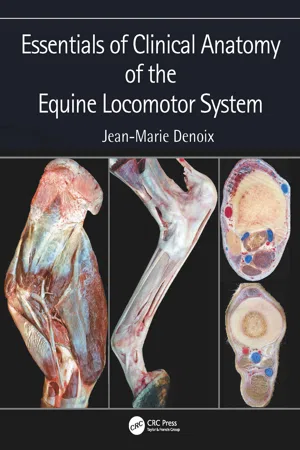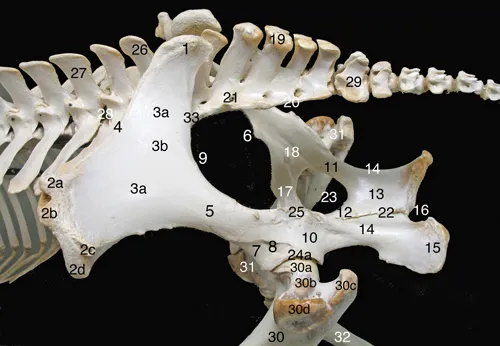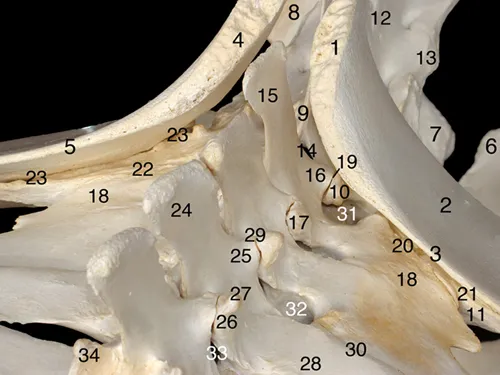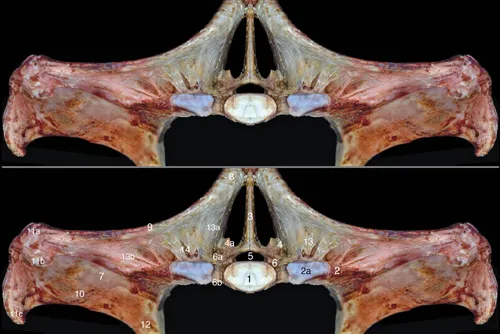
- 296 pages
- English
- ePUB (mobile friendly)
- Available on iOS & Android
eBook - ePub
Essentials of Clinical Anatomy of the Equine Locomotor System
About this book
Essentials of Clinical Anatomy of the Equine Locomotor System presents a unique photographic record of dissections showing the topographical anatomy of the locomotor system of the horse. Readers of this book will be able to see the position and relationships of the bones, joints, muscles, nerves and blood vessels that make up each region of the forelimb, vertebral column and hindlimb.
Key features:
- Important features of regional and topographical anatomy are presented using full-color photos of detailed dissections
- Anatomy is presented in a clinical context
- Preparations of cross-sectional anatomy facilitate interpretation of diagnostic imaging, such as ultrasonography, MRI images and CT scans
- All dissections are of fresh material, rather than preserved specimens, to demonstrate the appearance of tissues in the living animal, or at post mortem autopsy
This new atlas is essential for anybody involved in detailed anatomical study, complex lameness evaluation or advanced imaging techniques in horses. It will be a useful guide for veterinary students, and a reference for equine vets in practice.
Frequently asked questions
Yes, you can cancel anytime from the Subscription tab in your account settings on the Perlego website. Your subscription will stay active until the end of your current billing period. Learn how to cancel your subscription.
No, books cannot be downloaded as external files, such as PDFs, for use outside of Perlego. However, you can download books within the Perlego app for offline reading on mobile or tablet. Learn more here.
Perlego offers two plans: Essential and Complete
- Essential is ideal for learners and professionals who enjoy exploring a wide range of subjects. Access the Essential Library with 800,000+ trusted titles and best-sellers across business, personal growth, and the humanities. Includes unlimited reading time and Standard Read Aloud voice.
- Complete: Perfect for advanced learners and researchers needing full, unrestricted access. Unlock 1.4M+ books across hundreds of subjects, including academic and specialized titles. The Complete Plan also includes advanced features like Premium Read Aloud and Research Assistant.
We are an online textbook subscription service, where you can get access to an entire online library for less than the price of a single book per month. With over 1 million books across 1000+ topics, we’ve got you covered! Learn more here.
Look out for the read-aloud symbol on your next book to see if you can listen to it. The read-aloud tool reads text aloud for you, highlighting the text as it is being read. You can pause it, speed it up and slow it down. Learn more here.
Yes! You can use the Perlego app on both iOS or Android devices to read anytime, anywhere — even offline. Perfect for commutes or when you’re on the go.
Please note we cannot support devices running on iOS 13 and Android 7 or earlier. Learn more about using the app.
Please note we cannot support devices running on iOS 13 and Android 7 or earlier. Learn more about using the app.
Yes, you can access Essentials of Clinical Anatomy of the Equine Locomotor System by Jean-Marie Denoix in PDF and/or ePUB format, as well as other popular books in Medicine & Equine Veterinary Science. We have over one million books available in our catalogue for you to explore.
Information
Chapter I
THE PELVIS
I.1 Physical aspect

Fig. I.1 Caudolateral aspect of the equine pelvis. (A) Bones; (B) superficial aspect.
1- Sacral tuber; 2- Tuber coxae; 3a- Tuber ischiadicum, 3b- point of the croup; 4a- Greater trochanter, 4b- Hip; 5- Third trochanter; 6- Gluteus medius muscle; 7- Gluteus superficialis muscle; 8- Gluteofemoralis muscle; 9- Biceps femoris muscle; 10- Semitendinosus muscle; 11- Semimembranosus muscle; 12- Tensor fascia latae muscle; 13- Sacrum (median sacral crest); 14a- Caudal vertebrae, 14b- Tail.
I.2 Bones

Fig. I.2 Dorsolateral aspect of the equine pelvic bones.
Ilium: 1- Sacral tuber; 2- Tuber coxae, 2a- dorsocranial cuspid, 2b- ventrocranial cuspid, 2c- dorsocaudal cuspid, 2d-ventrocaudal cuspid; 3- Ilium wing, 3a- gluteal face, 3b- accessory gluteal line; 4- Ilium crest, 5- Ilium neck; 6- Psoas minor muscle tubercle; 7- Ilium body; 8- Lateral rectus femoris muscle area; 9- Major sciatic incisura;
Ischium: 10- Ischium body; 11- Lateral (acetabular) ramus; 12- Medial ramus; 13- Ischium table; 14- Minor sciatic incisura; 15- Tuber ischiadicum (ischiatic tuberosity); 16- Ischiatic arch;
Pubis: 17- Cranial ramus; 18- Obturator sulcus;
Sacrum: 19- Median sacral crest (five spinal processes); 20- Lateral sacral crest (fused transverse processes); 21- Dorsal sacral foramen;
Pelvis and connected bones: 22- Pelvic symphysis; 23- Obturator foramen; 24- Acetabulum, 24a- Acetabular margin; 25- Ischiatic spine (sciatic crest); 26- Spinal process of the sixth lumbar vertebra; 27- Fourth lumbar vertebra; 28- Intervertebral foramen; 29- First caudal vertebra; 30- Left femur, 30a- head, 30b- neck, 30c- major trochanter (caudal part); 30d- major trochanter (cranial part); 31- Right femur; 32- Right tibia; 33- Sacroiliac joint.

Fig. I.3 Ventral aspect of the equine pelvic bones.
Ilium: 1- Tuber coxae, 1a- dorsocranial cuspid, 1b- ventrocranial cuspid, 1c- ventrocaudal cuspid; 2- Ilium wing, 2a- iliac face, 2b- sacropelvic face (insertion of the interosseous sacroiliac ligament); 3- Ilium crest; 4- Ilium neck; 5- Arch line; 6- Psoas minor muscle tubercle; 7- Ilium body; 8- Medial rectus femoris muscle area; 9- Major sciatic incisura;
Pubis: 10- Pubis body; 11- Cranial ramus; 12- Caudal ramus, 12a- symphysial face; 13- Pubis pecten; 14- Accessory ligament sulcus;
Ischium: 15- Ischium body; 16- Lateral (acetabular) ramus; 17- Ischium table; 18- Medial ramus, 18a- symphysial face; 19- Tuber ischiadicum (ischiatic tuberosity); 20- Ischiatic arch;
Pelvis: 21- Pelvic symphysis; 22- Obturator foramen; 23- Acetabulum, 23a- acetabular margin, 23b- lunar surface, 23c- acetabular fossa, 23d- acetabular notch;
Sacrum: 24- First sacral vertebra; 25- Fourth sacral vertebra; 26- Sacral wing; 27- First ventral (intervertebral) sacral foramen; 28- Third ventral (intervertebral) sacral foramen; 29- Promontory; 30- Sacroiliac joint;
Lumbar spine: 31- Sixth lumbar vertebra (L6); 32- Transverse process of the fifth lumbar vertebra (L5, fused with L6); 33- Lumbar ventral intervertebral foramen; 34- Third lumbar vertebra (L3, ventral crest); 35- Transverse process of L3; 36- Intertransverse lumbosacral joint;37- Intertransverse synostosis between L5 and L6; 38- Intervertebral symphysis between L3 and L4.

Fig. I.4 Dorsal aspect of the equine pelvic bones.
Ilium: 1- Tuber coxae, 1a- dorsocranial cuspid, 1b- dorsocaudal cuspid, 1c- ventrocaudal cuspid; 2- Sacral tuber; 3- Ilium wing; 4- Ilium crest; 5- Ilium neck; 6- Ilium body; 7- Major sciatic incisura;
Ischium: 8- Ischium body; 9- Lateral (acetabular) ramus; 10- Ischium table; 11- Medial ramus, 11a- symphysial face; 12- Tuber ischiadicum (ischiatic tuberosity); 13- Ischiatic arch;
Pubis: 14- Cranial ramus; 15- Caudal ramus, 15a- symphysial face;
Pelvis: 16- Pelvic symphysis, 16a- cranial (pubic part), 16b- caudal (ischiatic) part; 17- Obturator foramen; 18- Ischiatic spine (sciatic crest); 19- Acetabulum, 19a- acetabular margin;
Sacrum: 20- Median sacral crest; 21- Lateral sacral crest; 22- Transverse process of the first sacral vertebra (sacral wing); 23- Right lumbosacral articular process joint; 24- Sacroiliac joint; 25- Third dorsal (intervertebral) sacral foramen; 26- Sacral canal (caudal opening); 27- First caudal vertebra (vertebral body);
Lumbar spine: 28- Transverse process of the third lumbar vertebra (L3); 29- Transverse process of the fifth lumbar vertebra (L5); 30- Right articular process joint between L3 and L4.

Fig. I.5 Dorsal aspect of the equine sacrum.
1- Spinal process of the first sacral vertebra (S1); 2- Vertebral arch of S1; 3- Left cranial articular process of S1; 4- Transverse process of the first sacral vertebra (sacral wing), 4a- auricular surface (contributing to the sacroiliac joint), 4b- insertion surface of the interosseous sacroiliac ligament; 5- Articular surface of the intertransverse lumbosacral joint seen through the cranial intervertebral incisura; 6- Median sacral crest, 6a- spinal process of the second sacral vertebra, 6b- spinal process of the fifth sacral vertebra; 7- First dorsal (intervertebral) sacral foramen; 8- Second dorsal (intervertebral) sacral foramen; 9- Lateral sacral crest; 10- First caudal vertebra, 10a- vertebral arch, 10b- vertebral body.

Fig. I.6 Craniolaterodorsal aspect of the lumbosacroiliac area.
Coxal bones: 1- Sacral tuber of the left ilium; 2- Ilium wing of the left ilium; 3- Ilium crest of the left ilium; 4- Sacral tuber of the right ilium; 5- Ilium crest of the right ilium; 6- Left ischium (angle between ilium arch and pelvic symphysis); 7- Right ischium (angle between ilium arch and pelvic symphysis); 8- Right tuber ischiadicum;
Sacrum: 9- Spinal process of the first sacral vertebra (S1); 10- (Cranial) articular process of S1; 11- Left transverse process of S1 (sacral wing); 12- Median sacral crest; 13- Lateral sacral crest; 14- Interarcual space between the last lumbar vertebra (L6) and S1;
Lumbar vertebrae and sacroiliac joints: 15- Spinal process of L6; 16- Caudal articular process of L6; 17- Cranial articular process of L6; 18- Transverse process of L6 (fused with the transverse process of the fifth lumbar vertebra (L5)); 19- Left lumbosacral articular process joint; 20- Left lumbosacral intertransverse joint; 21- Left sacroiliac joint; 22- Right lumbosacral intertransverse joint; 23- Right sacroiliac joint; 24- Spinal process of the fourth lumbar vertebra (L4); 25- Caudal articular process of L4; 26- Cranial articular process of L4; 27- Mammillary process; 28- Transverse process of L4; 29- Left articular process joint between L3 and L4; 30- Left intertransverse joint between L4 and L5; 31- Dorsal lumbosacral intertransverse foramen; 32- Dorsal intertransverse foramen between L4 and L5; 33- Left intervertebral foramen between L3 and L4; 34- Right cranial articular process of the third lumbar vertebra.
I.3 Dissected specimen

Fig. I.7 Ventral aspect of the roof of the pelvis: bones and ligaments.
1- Body of the first sacral vertebra (S1); 2- Transverse process of S1 (sacral wing); 3- Body of the third sacral vertebra (S3); 4- First ventral (intervertebral) sacral foramen; 5- Second ventral (intervertebral) sacral foramen; 6- Ilium wing; 7- Ilium neck; 8- Sacroiliac joint covered by the ventral sacroiliac ligament, 8a- caudomedial part, 8b- craniolateral part (covered by the iliopsoas muscle); 9- Lumbosacral intervertebral disc (sixth lumbar (L6) disc); 10- Lumbosacral intertransverse joint, 10a- joint space, 10b- lumbosacral intertransverse ligament; 11- Ventral ramus of the sixth lumbar nerve; 12- Body of the sixth lumbar vertebra (L6); 13- Transverse process of L6 (fused with L5 transverse process); 14- Fifth lumbar intervertebral disc; 15- Body of the fifth lumbar vertebra (L5); 16- Transverse process of L5 (fused with L6 transverse process); 17- Ventral intertransverse foramen between L5 and L6; 18- Intertransverse ligament; 19- Iliolumbar ligament.

Fig. I.8 Cranial aspect of the equine pelvis: dorsal part.
1- Vertebral body of the first sacral vertebra (S1); 2- Transverse process of S1 (sacral wing), 2a- articular surface of the intertransverse lumbosacral joint; 3- Spinal process of S1; 4- Left (cranial) articular process of S1, 4a- articular surface of the right artic...
Table of contents
- Cover
- Half-Title
- Title
- Copyright
- Contents
- Introduction
- Author
- CHAPTER A The proximal thoracic limb
- CHAPTER B THE BRACHIUM AND ELBOW
- CHAPTER C THE ANTEBRACHIUM
- CHAPTER D THE CARPUS
- CHAPTER E THE METACARPUS
- CHAPTER F THE DIGITAL AREA
- CHAPTER G THE NECK
- CHAPTER H THE BACK (THORACOLUMBAR REGIONS)
- CHAPTER I THE PELVIS
- CHAPTER J THE HIP AND THIGH
- CHAPTER K THE STIFLE
- CHAPTER L THE CRUS
- CHAPTER M THE TARSUS
- CHAPTER N THE METATARSUS
- CHAPTER O THE DIGITAL AREA OF THE PELVIC LIMB
- Index